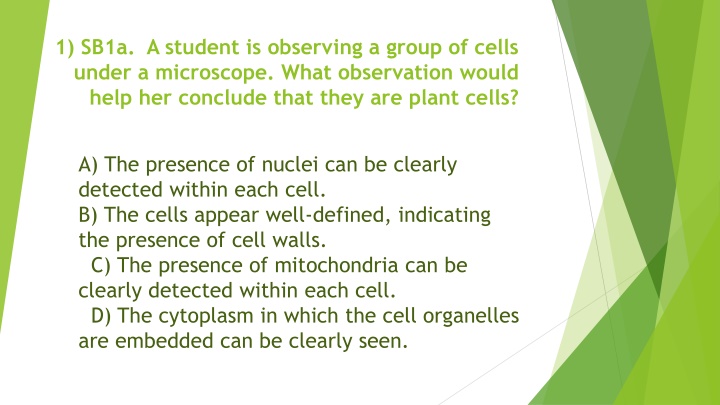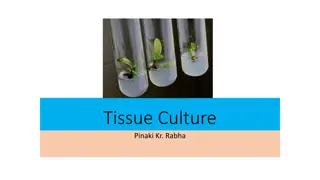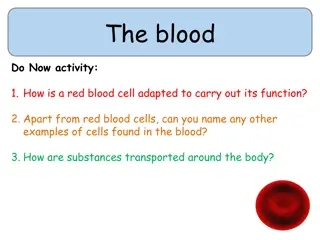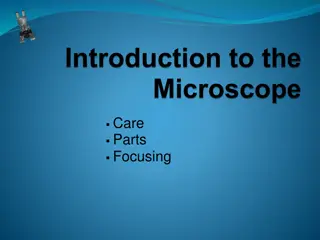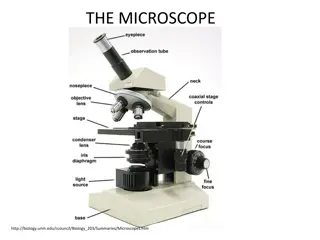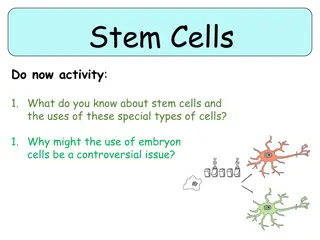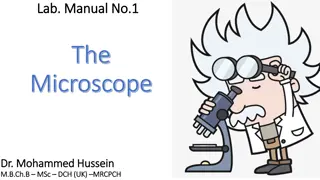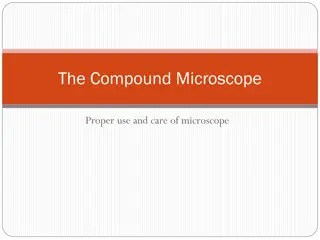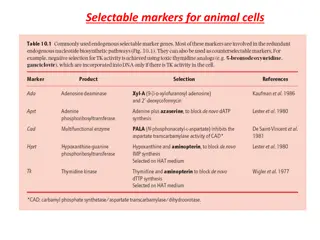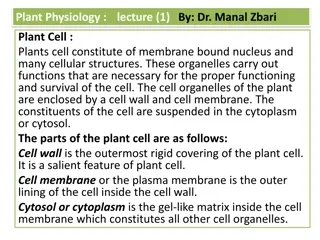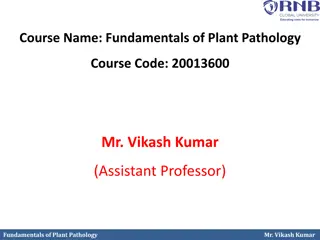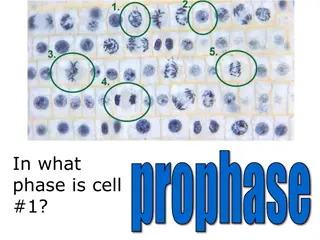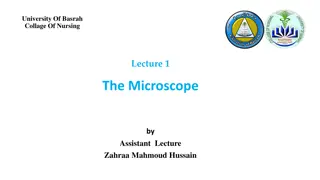Identifying Plant Cells Under Microscope
Observing well-defined cells with clear presence of cell walls would help conclude that the cells are plant cells, distinguishable from animal cells by the absence of cell walls. The detection of nuclei within each cell is a common characteristic observed in both plant and animal cells.
Download Presentation

Please find below an Image/Link to download the presentation.
The content on the website is provided AS IS for your information and personal use only. It may not be sold, licensed, or shared on other websites without obtaining consent from the author.If you encounter any issues during the download, it is possible that the publisher has removed the file from their server.
You are allowed to download the files provided on this website for personal or commercial use, subject to the condition that they are used lawfully. All files are the property of their respective owners.
The content on the website is provided AS IS for your information and personal use only. It may not be sold, licensed, or shared on other websites without obtaining consent from the author.
E N D
Presentation Transcript
1) SB1a. A student is observing a group of cells under a microscope. What observation would help her conclude that they are plant cells? A) The presence of nuclei can be clearly detected within each cell. B) The cells appear well-defined, indicating the presence of cell walls. C) The presence of mitochondria can be clearly detected within each cell. D) The cytoplasm in which the cell organelles are embedded can be clearly seen.
B) The cells appear well-defined, indicating the presence of cell walls.
2. The graph illustrates the relative activity levels of three common enzymes. Which enzyme is most active at a neutral pH of 7? A) pepsin B) trypsin C) amylase D) pepsin and amylase
3) SB1c ___________ are lipids that store energy and are typically composed of multiple building blocks containing three fatty acids attached to a glycerol molecule. A) Fats B) Phospholipids C) Proteins D) Steroids
4) SB1d. About two-thirds of a cell is composed of water. What is the name of the process in which water is moved into or out of the cell membrane to maintain homeostasis? A) diffusion B) endocytosis C) exocytosis D) osmosis
5) SB2a. Changes in the DNA sequence, or mutations, help drive A) amino acid coding. B) deamination events. C) evolutionary change. D) environmental interaction.
6) SB2c. Each body cell of an octopus contains thirty-two chromosomes. The number of chromosomes in a octopus egg cell will be A) 8. B) 16. C) 32. D) 64.
7) SB2d. Parents can pass on chromosomes to their children that are different than their own when the new gene combinations are created by A) crossing over of sister chromatids during meiosis. B) crossing over of sister chromatids during mitosis. C) crossing over of homologous chromosomes during mitosis. D) crossing over of homologous chromosomes during meiosis
D) crossing over of homologous chromosomes during meiosis
8) SB2f. Which technique would be the most useful in determining the father of a child in a paternity suit? A) DNA fingerprinting B) karyotype of father and child C) polymerase chain reaction (PCR) D) computer-generated parental Punnett square
9) SB3a. The two main processes by which plant cells absorb, release, and use energy are A) fermentation and respiration. B) digestion and photosynthesis. C) photosynthesis and respiration. D) aerobic and anaerobic respiration
10) SB3b. Which group of organisms is most closely related to Archeabacteria? A) Animalia B) Fungi C) Plantae D) Protista
11) SB3c. Scientists use the binomial nomenclature to identify and name organisms. All BUT one statement is true about the binomial system of classification. Which statement is false? A) The family and species name are given. B) It is a system devised by Carolus Linnaeus. C) The name of the organism is written in Latin. D) The system is universally accepted so an organism has the same name to all biologists.
12) SB3d. The protein coat that envelopes the viral genetic material is known as a: A) Virion B) Case C) Viroid D) Capsid
13) SB4a. Most of the trees of Denali Park, Alaska, are evergreen spruce. The soil in this area is rich and acidic. What biome is Denali Park located in? A) taiga B) tundra C) arctic forest D) temperate forest
14)SB4b. In this food chain, we could hypothetically assume that for every kilogram of biomass in the osprey eagle, it would require __________ kilograms of shrimp to keep the food chain balanced. A) 10 B) 100 C) 1,000 D) 10,000
15)SB4d Which is a reason for the rise of nitrate levels in ground water? A) overuse of fertilizers B) ammonification by animals C) soil erosion at grasslands D) nitrogen fixation by Azotobacter
16)SB5a. In order to support his theory of evolutionary change, Charles Darwin concentrated his studies on the many species of finches in the Galapagos Islands. Darwin noted that many of the birds had different shapes and styles of beak. What is a possible explanation for what Darwin observed? A) The birds had beaks that were adapted for feeding differently. B) Some birds had been injured by predators and were poor competitors. C) People had bred the bird to have beaks with varied shapes and sizes. D) The birds had different beaks because females preferred certain beak others. shapes over
A) The birds had beaks that were adapted for feeding differently.
17)SB5b. The pygmy hippo, shown in the photograph, typically weighs no more than 500 pounds and is about the size of a large pig. The much larger river hippopotamus usually weighs between 3,000 and 6,000 pounds. There are no living species of hippos that are medium-sized. Which term is used to describe evolutionary selection which results in greater numbers of individuals at the extremes of the distribution and few at the center of the distribution? A) adaptive B) directional C) disruptive D) validating
18)SB5c. About 96% of the information in human DNA is found in gorilla DNA. This evidence supports which statement? A) Humans evolved from gorillas. B) Gorillas and humans diverged from a common ancestor. C) As gorillas evolve, they will become more similar to humans. D) Gorillas and humans are too different for meaningful genetic comparisons
B) Gorillas and humans diverged from a common ancestor.
19) SB5c. Whales are thought to have evolved from land animals similar to large otters. As evidence of this, whales have useless leg bones (structure C) that float inside their bodies. These leg bones are ___________ structures. A) vestigial B) homologous C) analogous D) evolutionary
20)SB5d) The snowshoe rabbit has white fur in winter and dark fur in summer. What is the main survival advantage of this fur color change to the rabbit? A) The light fur keeps the rabbit from getting sunburned in summer. B) The fur color is an adaptive form of camouflage to avoid predators. C) The dark fur absorbs more sunlight so the rabbit is warmer in winter. D) The white fur is more valuable to fur trappers, so the animal will be trapped and better fed in winter.
B) The fur color is an adaptive form of camouflage to avoid predators.
21) SB1a. Your science teacher has asked the class to make a cell city model. Which building or business in the city could represent the mitochondria, and why? A) city dump - waste storage B) city hall - control center C) roads - transportation system D) power company - produces energy
22) SB1b. In the lock-and-key model of enzyme action, the ___________ fits into the __________ of the enzyme. A) product; substrate. B) active site; product. C) substrate; active site. D) active site; substrate.
23) SB1c. All BUT one of the following is a component of nucleic acids. Nucleic acids DO NOT contain A) phosphates. B) amino acids. C) ribose sugars. D) nitrogenous bases.
24)SB1d. In some freshwater organisms there is a structure called a contractile vacuole that regulates water movement into and out of the cell. What explains the existence of the CV? A) The CV prevents the organism from drying out. B) The CV assists the organism in capturing prey. C) The CV helps the organism move through the water. D) The CV helps the organism maintain osmotic pressure.
D) The CV helps the organism maintain osmotic pressure.
25) SB2b. A single strand of DNA contains the following nine nucleotides in this order: ACT TAT GGA. What sequence of bases will be present on the complementary strand of DNA? A) UGA AUA CCT B) ACT TAT GGA C) ACU UAU GGA D) TGA ATA CCT
